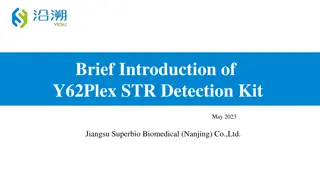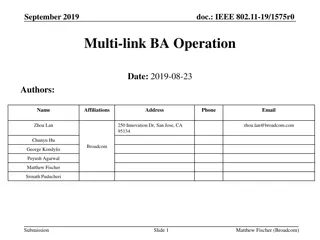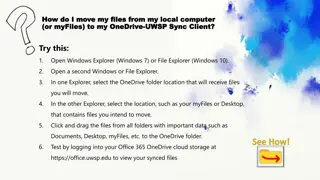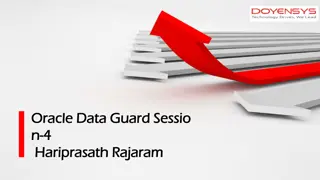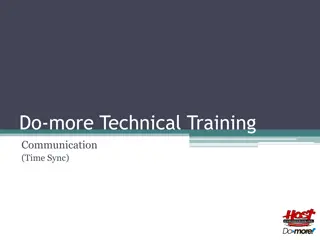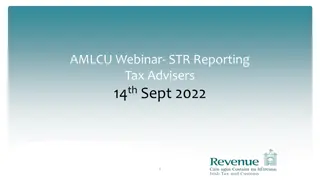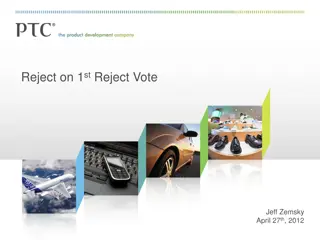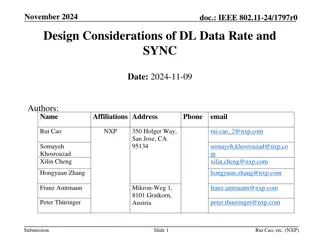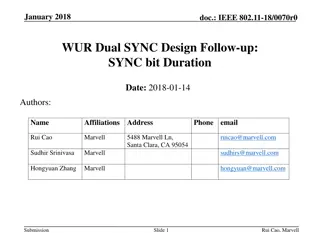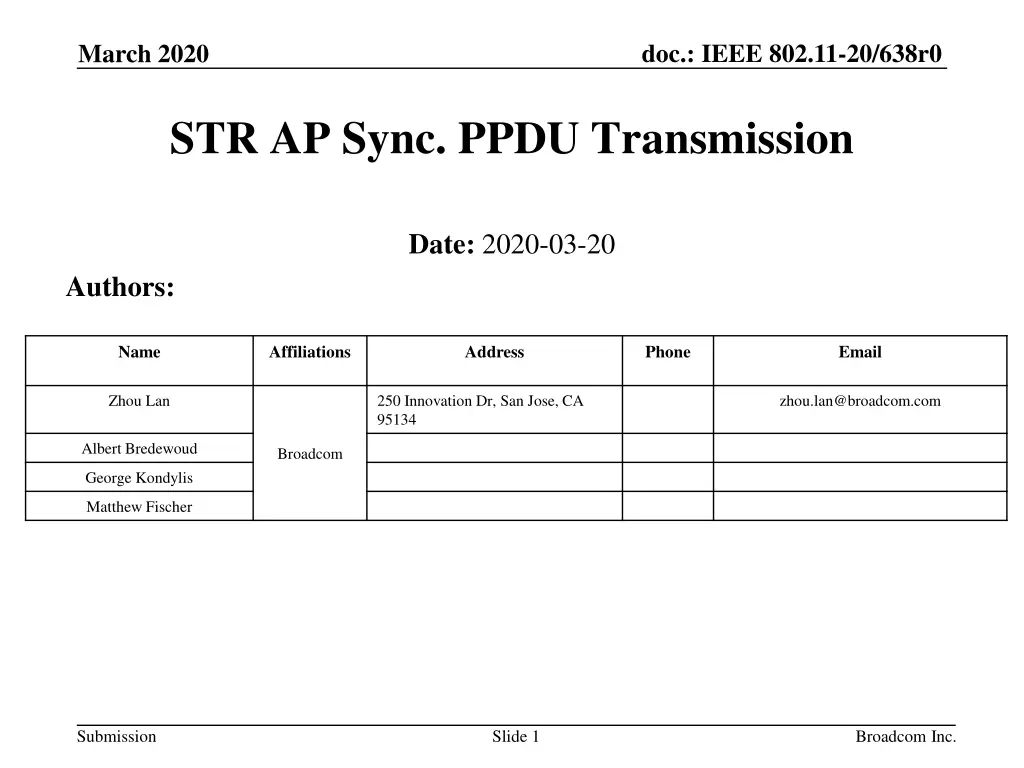
Enhancing High Throughput Performance in IEEE 802.11-20/638r0
"Proposing synchronized PPDU transmission for IEEE 802.11-20/638r0 to improve throughput performance. Addressing issues with STR Async transmissions, RTS/CTS exchanges, and non-STR STA capabilities. Solutions presented for better data transmission efficiency."
Download Presentation

Please find below an Image/Link to download the presentation.
The content on the website is provided AS IS for your information and personal use only. It may not be sold, licensed, or shared on other websites without obtaining consent from the author. If you encounter any issues during the download, it is possible that the publisher has removed the file from their server.
You are allowed to download the files provided on this website for personal or commercial use, subject to the condition that they are used lawfully. All files are the property of their respective owners.
The content on the website is provided AS IS for your information and personal use only. It may not be sold, licensed, or shared on other websites without obtaining consent from the author.
E N D
Presentation Transcript
doc.: IEEE 802.11-20/638r0 March 2020 STR AP Sync. PPDU Transmission Date: 2020-03-20 Authors: Name Affiliations Address Phone Email Zhou Lan 250 Innovation Dr, San Jose, CA 95134 zhou.lan@broadcom.com Albert Bredewoud Broadcom George Kondylis Matthew Fischer Submission Slide 1 Broadcom Inc.
doc.: IEEE 802.11-20/638r0 March 2020 Summary Aync. transmissions are supported by a STA that is STR capable When a STR AP transmits to a non-STR STA, the ending time of the PPDUs are aligned to help non-STR STA operation This contribution proposes to allow STR AP sync. PPDU transmission for high throughput scenario Submission Slide 2 Broadcom Inc.
doc.: IEEE 802.11-20/638r0 March 2020 Recap-STR AP Async. Transmission Independent EDCA on multiple links Async. PPDU TX starts on the link that completes back off Sync. PPDU ending time alignment[1][2] to help the non STR STA avoiding concurrent TX/RX operation Triggered BA/MBA or relaxing SIFS requirement to align the starting time of the next Sync. PPDU Async. TX Sync. RX TXOP owned by AP1 SIFS AMPDU+Trigger AMPDU+Trigger AP 1 STA 1 AP 1 Backoff SIFS SIFS BA/MBA BA/MBA TXOP owned by AP2 SIFS AMPDU+Trigger AMPDU+Trigger AP 2 Other TX STA 2 AP 2 Backoff SIFS SIFS BA/MBA BA/MBA Submission Slide 3 Broadcom Inc.
doc.: IEEE 802.11-20/638r0 March 2020 Issue of STR Async. Transmission RTS/CTS exchanges is critical for high throughput traffic protection [3] has described 3 scenarios where RTS/CTS exchanges are compromised due to non-STR capabilities of the STA [3] has also discussed a sub optimal solution of CTS-to-self frame transmission This contribution describe another problematic RTS/CTS scenario that may impact the throughput dramatically Assuming the congestion are on the same level, back off on multiple links may not complete at the same time, but close enough so that there is overlapping between RTS/CTS exchanges across multiple links The CTS TX on one link may damage the RTS RX on another link and vice verse. In such case, the following data transmissions are blocked Async. TX Sync. RX TXOP owned by AP1 SIFS RTS AMPDU+Trigger AMPDU+Trigger AP 1 STA 1 AP 1 Backoff SIFS SIFS SIFS CTS BA/MBA BA/MBA TXOP owned by AP2 SIFS RTS SIFS AMPDU+Trigger AMPDU+Trigger AP 2 STA 2 AP 2 Backoff SIFS SIFS SIFS CTS BA/MBA BA/MBA Submission Slide 4 Broadcom Inc.
doc.: IEEE 802.11-20/638r0 March 2020 Issue of STR Async. Transmission (cont.) Async. PPDU transmission doesn t provide optimized high throughput performance Single link provides up to 11.4Gbps capacity @320 MHz, 4SS, 4K QAM. Up to 8 M bytes can be transmitted with in one TXOP (i.e. 5.4 ms) 8 M bytes cover 1024 MPDUs (assuming 1500 bytes MSDU, 4 MSDU per MPDU) Now here is the problem as shown in the following diagram AP1 completes back off on the first link and decides to transmit, how to decide aggregation size X on link 1? Option 1: Aggregate up to 1024 MPDU since the TXOP is sufficient Then AP2 completes back off on link 2, it can only pick up QoS Data from different TID Option 2: Aggregate up to X MPDUs AP2 may not even be able to complete back off, technically no way to decide X Even if AP2 completes back off and can do aggregation from X to Y, but it is already too late for AP1 to re- aggregate (L-SIG already on the air) so that the end time alignment can not be achieved Async. PPDU transmission may provide the most channel access opportunities but not sufficient for the high through usage case Async. TX Sync. RX 5.4 ms 0-X MPDUs AMPDU+Trigger@11.4 Gbps AP 1 STA 1 AP 1 Backoff SIFS BA/MBA X-Y MPDUs AMPDU+Trigger@8.6 Gbps AP 2 Other TX STA 2 AP 2 Backoff SIFS BA/MBA Submission Slide 5 Broadcom Inc.
doc.: IEEE 802.11-20/638r0 March 2020 Allow STR AP Sync. PPDU Transmission Option 1: Independent EDCA on each link. Sync. PPDU TX starts once back off on either link completes and PIFS check passes on the other link Regulation support 160/80+80 type of operation. 11be should supports this mode anyway (maybe with some constrains?) Option 2: adopting the proposal in [3] for STR AP: Independent EDCA on each link. RTS TX starts on the link that completes back off. CTSs TX start on multiple links if NAV and CCA check passes to enable the following sync. PPDU TX on multiple links A low complexity feature that provides good protection for MLO. There is regulation uncertainty and unfairness issue. But the NAV check and CCA check on the second link mitigates the unfairness issue. Option 3: Independent EDCA on each link. Sync. PPDU TX starts once back off on either link completes and PIFS check passes on other links. The remaining back off counter is stored The next EDCA attempt adds the truncated back off of the first transmission to the new back off counter to account for the unfairness issue A low complexity feature as well that addresses both regulation and unfairness issues Async. TX Sync. RX TXOP owned by AP1 SIFS SIFS RTS AMPDU+Trigger RTS AMPDU+Trigger AP 1 PIFS STA 1 AP 1 Backoff SIFS SIFS SIFS SIFS CTS BA/MBA CTS BA/MBA SIFS SIFS RTS RTS AMPDU+Trigger AMPDU+Trigger PIFS AP 2 STA 2 BF counter += 4 SIFS SIFS SIFS SIFS CTS BA/MBA CTS BA/MBA Remaining backoff counter = 4 Submission Slide 6 Broadcom Inc.
doc.: IEEE 802.11-20/638r0 March 2020 Conclusion Async. operation should cover some of STR AP to Non-STR STA DL data transmission scenarios For high throughput transmission where RTS/CTS protection is critical, we propose to allow a mode that enables STR AP to transmit data to non-STR STA and solicits acknowledgement using sync. PPDUs Submission Slide 7 Broadcom inc.
doc.: IEEE 802.11-20/638r0 March 2020 Straw poll 1 Do you agree 802.11be define a mode of operation that allows STR AP transmits Sync. PPDUs to non-STR STA and solicits acknowledgement YES NO ABS Submission Slide 8 Broadcom inc.
doc.: IEEE 802.11-20/638r0 March 2020 Reference [1] IEEE802.11-20/26r3, MLO: Sync PPDUs [2] IEEE802.11-20/106r4, Follow up on performance aspects of mlink ops with constrains [3] IEEE802.11-20/291r1, MLO Async. and Sync. Operation Discussion Submission Slide 9 Broadcom inc.
doc.: IEEE 802.11-20/638r0 March 2020 Annex-Issue of STR AP Async. Transmission RTS/CTS case 1 Allow NO RTS/CTS exchange on the second link that finish back off late Async. TX Sync. RX TXOP owned by AP1 SIFS RTS AMPDU+Trigger AMPDU+Trigger AP 1 STA 1 AP 1 Backoff SIFS SIFS SIFS CTS BA/MBA BA/MBA TXOP owned by AP2 SIFS AMPDU+Trigger AMPDU+Trigger AP 2 Other TX STA 2 AP 2 Backoff SIFS SIFS BA/MBA BA/MBA Submission Slide 10 Broadcom Inc.
doc.: IEEE 802.11-20/638r0 March 2020 Annex-Issue of STR AP Async. Transmission RTS/CTS case 2 Do RTS/CTS on the second link Issue: if the backoff on the second link finish during the RTS/CTS exchange of link 1, the RTS/CTS exchange on both link fail Async. TX Sync. RX TXOP owned by AP1 SIFS RTS AMPDU+Trigger AMPDU+Trigger AP 1 STA 1 AP 1 Backoff SIFS SIFS SIFS CTS BA/MBA BA/MBA TXOP owned by AP2 SIFS RTS SIFS AMPDU+Trigger AMPDU+Trigger AP 2 Other TX STA 2 AP 2 Backoff SIFS SIFS SIFS CTS BA/MBA BA/MBA Submission Slide 11 Broadcom Inc.
doc.: IEEE 802.11-20/638r0 March 2020 Annex-Issue of STR AP Async. Transmission RTS/CTS case 3 NO RTS/CTS on the second link, instead a CTS-A is sent out when back off finished on the second link Issue: not as good protection as RTS/CTS exchange on the second link Async. TX Sync. RX TXOP owned by AP1 SIFS RTS AMPDU+Trigger AMPDU+Trigger AP 1 STA 1 AP 1 Backoff SIFS SIFS SIFS CTS BA/MBA BA/MBA TXOP owned by AP2 SIFS SIFS CTS-A AMPDU+Trigger AMPDU+Trigger AP 2 Other TX STA 2 AP 2 Backoff SIFS SIFS BA/MBA BA/MBA Submission Slide 12 Broadcom Inc.

